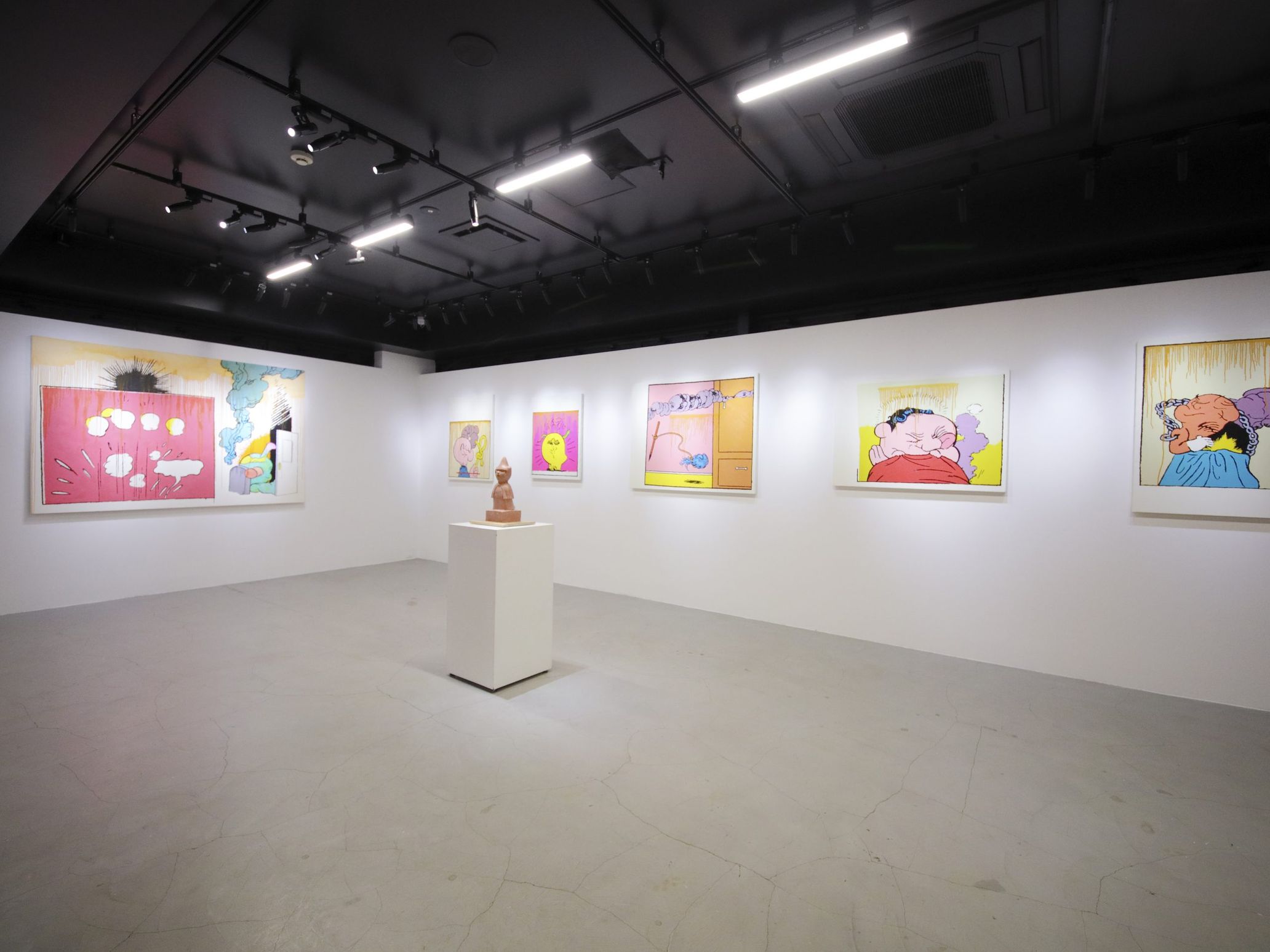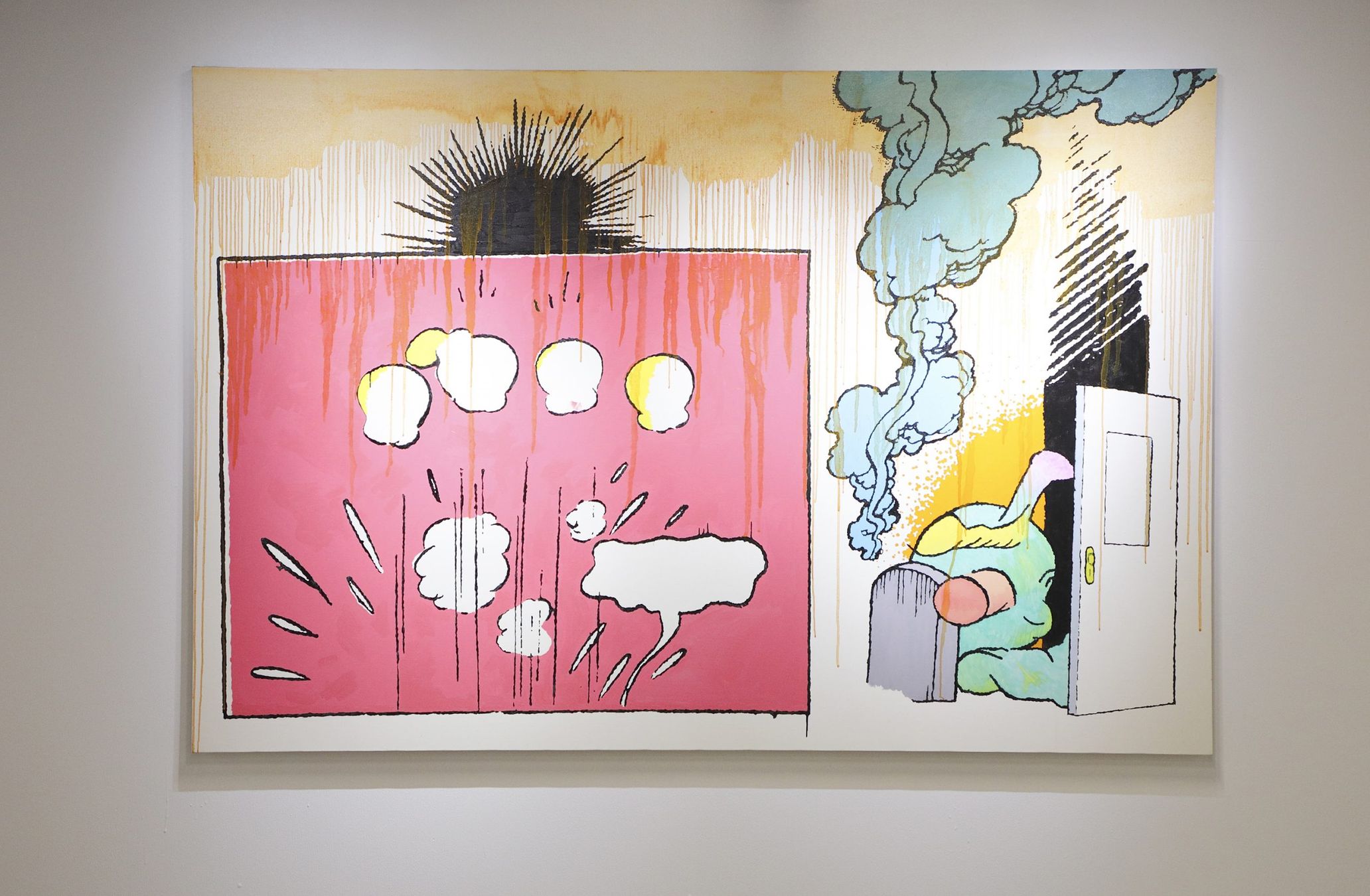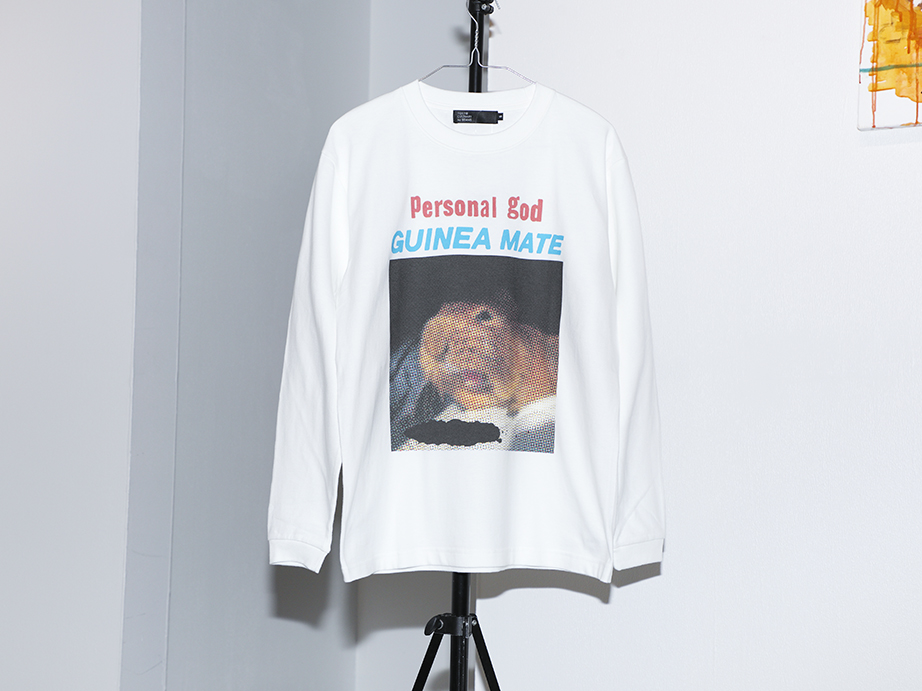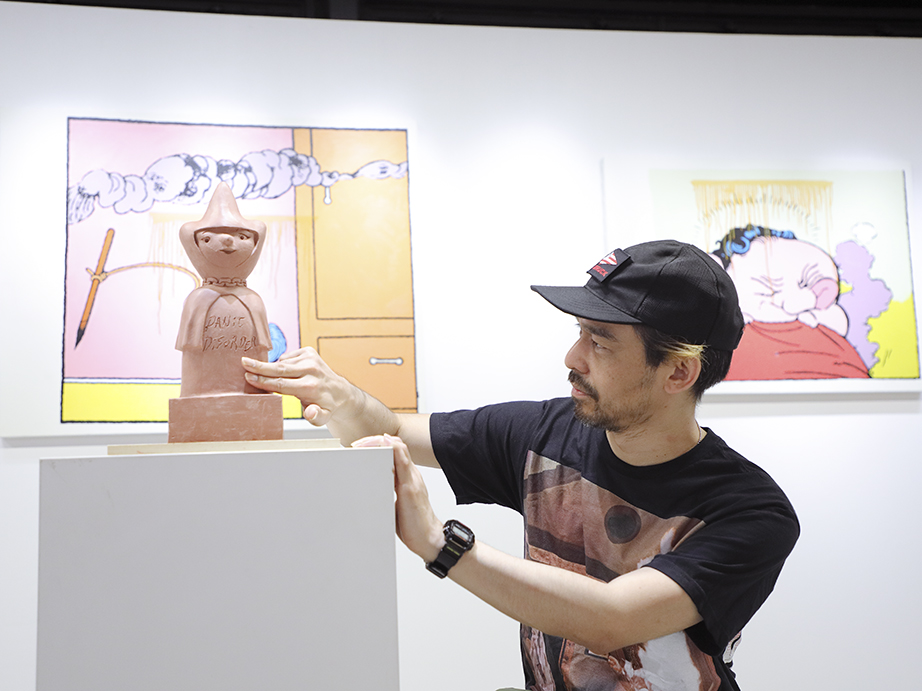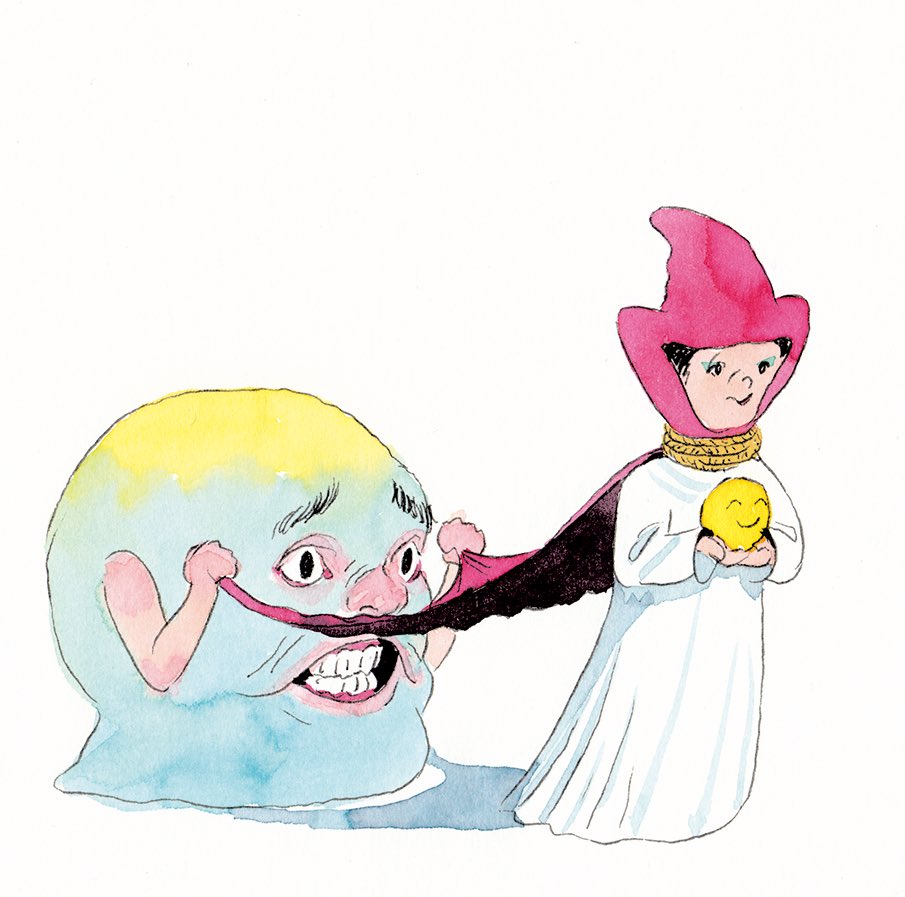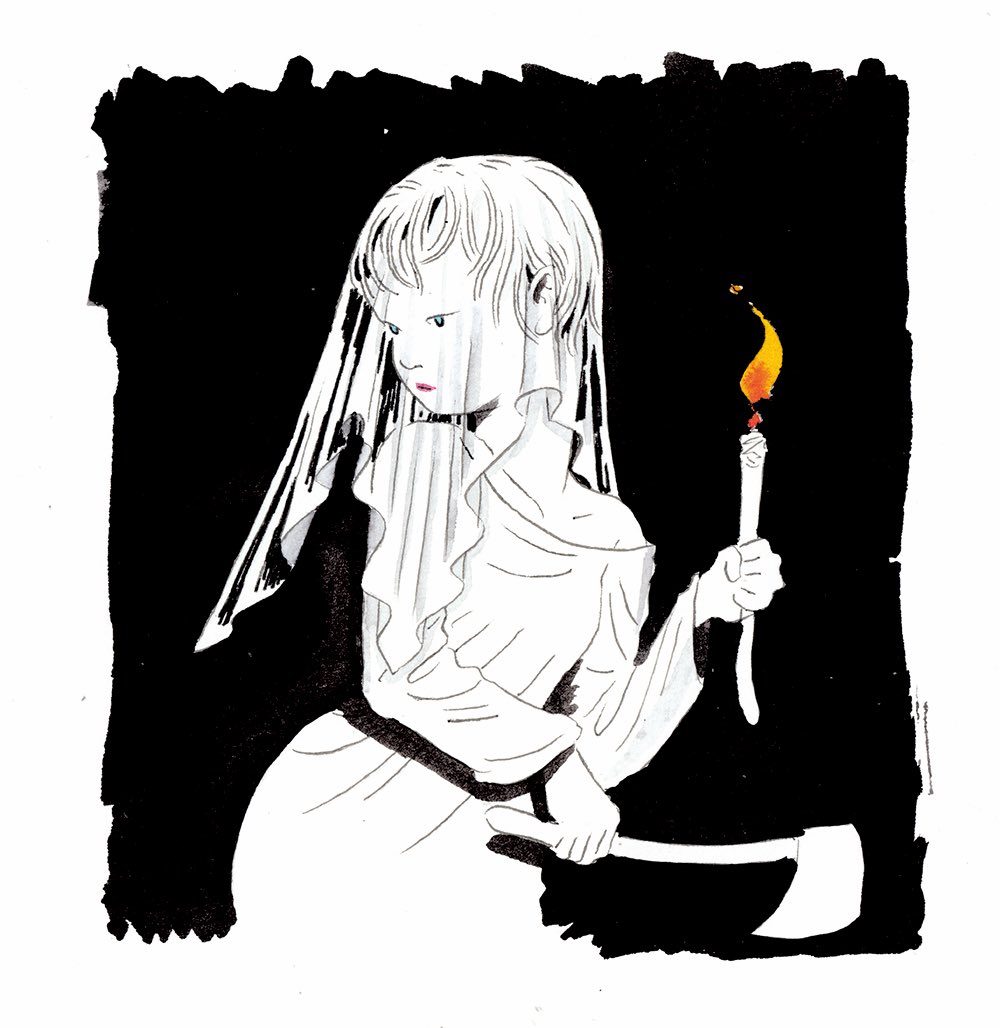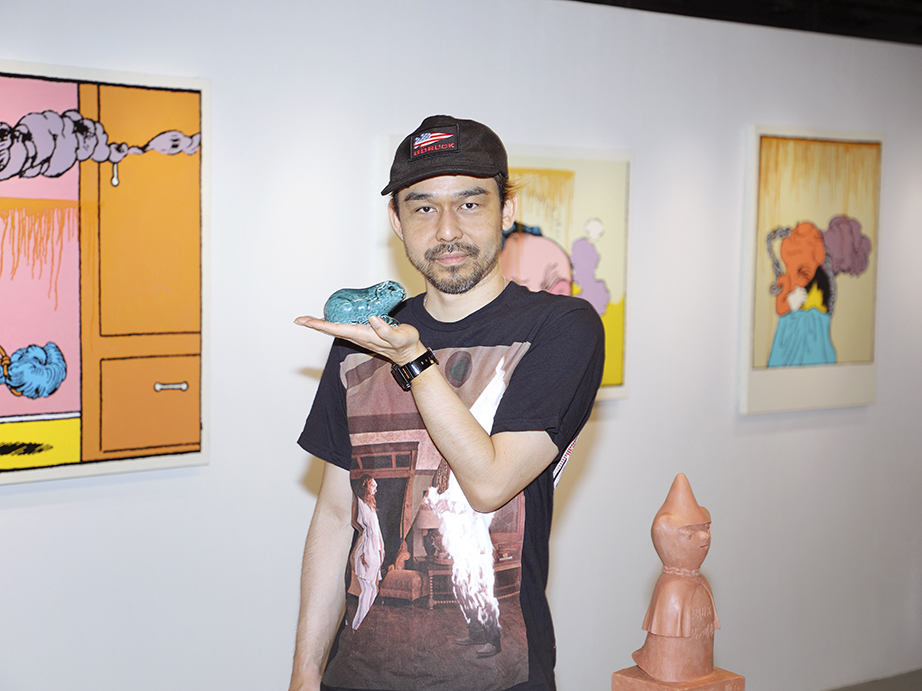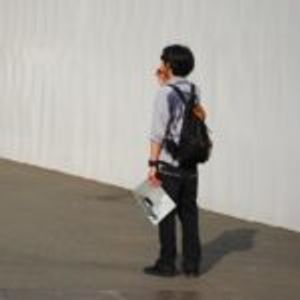Isamu Gakiya is an artist who mixes analog and digital techniques such as drawing, collage, and painting to create a unique universe. His solo exhibition, “GUNIEA MATE,” which is currently showing at B Gallery in Shinjuku, features oil paintings based on digital collages. We asked him about the intent behind his work and why he chose oil paintings.
Mixing digital and analog
――Your current solo exhibition “GUNIEA MATE” feature oil paintings based on digital colleges. How did you create these?
Isamu Gakiya (Hereinafter Gakiya): I take the outlines from American comics and other old printouts, import them into the computer, and then deconstruct them. Then, I combine the digital decompositions and draw them in analog form. For example, if you look at the face of one of the characters, you’ll see the features are a collage of lines from American comic book character’s faces or other prints. You could call it a collage of lines.
――I noticed all of your work uses a paint dripping technique.
Gakiya: It’s the finishing touch on my pieces. For my work in this exhibition, I made up an imaginary religion, and those drips are a ritual for this religion. That’s why all the work has paint drips. I think rituals can be a beautiful thing.
――You work with acrylics, paints, and a number of techniques. Why did you choose oil painting this time?
Gakiya: I chose oil painting because I wanted my works to be long-lasting, and I also figured I should try my hand at oil painting. Unlike acrylics, oil paints don’t lose color when painted on a canvas, so they stay the same. I liked that about oil painting when I tried it. Also, as for why I recently decided to try my hand at oil painting–I accidentally ordered oil-painting canvases when I ordered canvases for my last exhibition (“Pineal Body,” which took place in March). (laughs) Since I’d already made the mistake and there was nothing else I could do, I decided to stand up to the challenge. As a result, I discovered all kinds of things, so I was glad that I was able to try oil painting when I did.
Don’t rely on an existing God and religion–create your own instead
――I want to ask you about the theme of your next exhibition. About your theme, “GUINEA MATE,” you said, “I depict people by defining their personal beliefs in modern society as ‘GUINEA MATE.’” What exactly is GUINEA MATE?
Gakiya: The truth is that I made a spelling mistake. Honestly, it’s supposed to be GUINEA MATE, but I decided to just keep it as is this time. (laughs) GUINEA comes from “guinea pig,” and I love guinea pigs so much that I actually own one.
If I explained it more in detail, I think that in this world, there isn’t a God who can save us. If God did exist, there wouldn’t be war, discrimination, or suffering. But that’s not reality. So I thought rather than depend on an existing God or religion, it’d be better to make my own. I can save myself. I’d been thinking about this for years, and it became the theme of this exhibition. So my God is a guinea pig.
――So your imagined religion is “GUNIEA MATE.” On Twitter, you said that “GUNIEA MATE” has 108 doctrines, and you uploaded 6 of them. What other doctrines are there?
Gakiya: I chose 108 doctrines based on the number of bonno (defilements of man in Buddhism), but I haven’t decided all of them yet. (laughs) I’d like to keep creating them at a slow pace–it’d be great to have 108 by the time I die.
――Your exhibition has one three-dimensional object. Could you tell me about this work?
Gakiya: I made this three-dimensional piece myself, starting from the modeling, and it was my first time doing that. “PANiC DiSORDER” is carved into the chest, the name of the illness that I’ve suffered from for over ten years. I’ve been in a state of remission for some time, so I made that piece as a jizo (a Buddhist statue of protection) to memorialize the end of my suffering. I’d like to eventually turn this work into a garage kit and start a pre-sale during the exhibition.
American culture is in my blood and my bones
――Your work, including what we see in this current exhibition, has a really unique, pop use of color and freestyle composition. Where do you find inspiration for your work?
Gakiya: I’m originally from Okinawa, and my hometown has a lot of American culture left over from after the war. I think that’s influenced me a lot. On channel 6 in Okinawa, there are programs broadcast on TV for the American military, so I was able to watch those back home. As a kid, I grew up watching American cartoons and movies.
――Is there anything else that’s inspired you?
Gakiya: I love horror movies, so that’s also influenced me too. So American culture, like horror movies and comics, is part of me, in my blood and my bones. And I think that comes out in my work.
――Do you still purchase and read American comics today?
Gakiya: I’m not super into a specific character like Superman or Batman, or a specific time period of comics, but I still do look for old American comics. With new American comics, the lines are a bit too pretty and it doesn’t feel right. For better or for worse, I guess it’s just too good. With old American comics, I’m drawn to how sometimes the printed lines will be off, or there’ll be too much ink.
It’s important to speak up about the world, but you should also take care of yourself
――Were you affected by the coronavirus?
Gakiya: My client work wasn’t particularly affected. And while I wouldn’t go as far as to say it was a good thing, I like staying in, so being able to have meetings online and not having to leave my house has made my life easier from a mental health perspective.
――What were you doing during quarantine?
Gakiya: I was playing with my guinea pig and playing video games at home. Also, I was drawing one piece a day and posting that online. I haven’t been able to draw those at the moment because I’ve been preparing for my exhibition, but I’ve accumulated quite a lot, so I plan to exhibit this work as a summary of my year at my upcoming exhibition at the end of the year.
――You do a lot of music-related client work. Is this different from your personal work?
Gakiya: For music-related client work, a lot of the time I’m given a concept and then I’m told to run free with it, which I’m happy about. But since it’s still work for someone else, it may not be as analog as my creative work. When you do analog work, it’s harder to edit, so I mainly work digitally and then mix a little bit of analog in. But for the recent work I had the pleasure of doing for Ayuni D, I drew everything analog.
――This is a theme included in your exhibition, but how do you feel about the state of modern society? And do you have any advice for how to survive within today’s world?
Gakiya: It’s a hard society to exist in. I’d say we’re all in a state of stagnant consciousness because we’re all staying home more than ever due to corona, and we’re spending more time with ourselves than ever before. It’d be great if that could move us in a positive direction, but I think there are a lot of people who are moving in the opposite direction.
I mentioned it earlier, but when I talk about saving yourself, I also mean that you should affirm yourself. If you can affirm yourself, you’ll stop negative patterns of thinking. In the end, it’s all about how you handle things. In the future, I think our individual ways of thinking will become more important. It’s important to speak up about the world, but I also think it’s important to take care of yourself.
Isamu Gakiya
Gakiya is an artist from Okinawa who currently resides in Tokyo. After teaching himself how to paint in his hometown, he moved to Tokyo at age 25. He’s gained popularity for his illustrations, which are inspired by post-war American horror and sci-fi movies and American comics. Currently, in addition to working as an illustrator, he actively participates in art exhibitions and festivals as he expands his own work as an artist.
http://gakiyaisamu.com/
Twitter:@gakism
GUNIEA MATE
Date: – November 1
Venue: B GALLERY
Address: Shinjuku-ku, Tokyo 3-32-6 BEAMS JAPAN 5F
Time: 12:00 – 20:00
Admission: Free
https://www.beams.co.jp/news/2153/
Photography Shinpo Kimura
Translation Aya Apton

